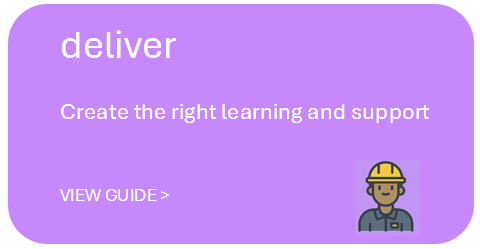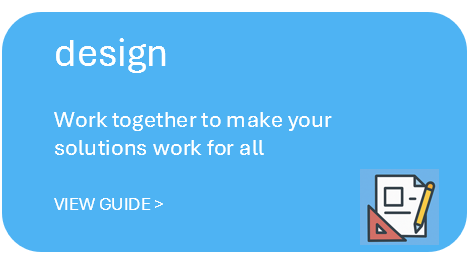partner
Build partnerships that support shared goals
Introduction
Degree-Level Apprenticeships offer an opportunity to rethink how we deliver education and employment, but this opportunity will be wasted unless we centre the voices and leadership of communities historically excluded from degree-level learning.
Partnership isn’t just about inclusion. It is about relevance, quality, and integrity. A DLA that doesn’t work for Māori, Pacific, or disabled learners doesn’t work.
What this involves
Partnership involves:
Honouring Te Tiriti o Waitangi in both intention and action
Embedding Pacific values into programme design and delivery
Designing for accessibility and disability justice, not after-the-fact accommodation
Creating shared ownership of solutions rather than one-size-fits-all models
This section complements the five lifecycle stages by elevating partnership with equity groups as a foundational and ongoing practice, not a discrete step.
Iwi and Māori Organisations
Why your leadership matters: As mana whenua, kaitiaki, and Tiriti partners, iwi and Māori organisations play critical roles as employers, educators, connectors, and advocates for Māori aspirations in education and employment.
Ways to partner:
Co-design the kaupapa: Ensure DLAs are grounded in Māori aspirations, values, and models of success
Create pathways into iwi-led industries: DLAs can strengthen succession in sectors such as infrastructure, trades, environmental management, and hauora
Support ākonga Māori holistically: Provide cultural, pastoral, or financial support through iwi trusts or partnerships
Advocate for system accountability: Ensure providers and employers uphold their responsibilities under Te Tiriti and advance Māori outcomes
What to look for in a good partnership:
Early engagement, not after-the-fact endorsement
Respect for tikanga, reo, and Māori data sovereignty
Clear benefits for whānau, hapū, and iwi
Shared decision-making and visibility throughout the DLA lifecycle
Mā te huruhuru ka rere te manu — With the right feathers, the bird will fly.
Pacific Peoples and Communities
Why your voice matters:
Pacific peoples bring deep strength, leadership, and intergenerational commitment to education—but continue to face structural barriers in accessing and completing degree-level learning.
DLAs offer a chance to create culturally safe, financially accessible, and practically grounded pathways, but only if designed in partnership with Pacific learners, families, and communities.
Ways to partner:
Design for relationality: Build learning journeys that reflect Pacific values—family, community, respect, and service
Strengthen cultural safety: Ensure providers and employers understand Pacific learners’ contexts and embed inclusive practices
Involve Pacific leaders: Engage with Pacific educators, community groups, and workforce champions in both the public and private sectors
Support transition and navigation: Use trusted advisors or community connectors to guide learners into and through DLAs
What to look for in a good partnership:
Programmes that honour Pacific identity and belonging
Flexible study and work models that accommodate wider responsibilities
Visibility of Pacific staff and leaders in both TEOs and workplaces
Long-term commitment, not one-off initiatives
O le ala i le pule o le tautua — The pathway to leadership is through service.
Employers
Your role: Build workplace environments and pathways that are culturally safe, inclusive, and accessible—and create space for shared leadership with community partners.
What to focus on:
Engage early with iwi, Pacific, and disability organisations when developing roles, pathways, or recruitment plans
Train supervisors and managers in cultural safety, disability awareness, and inclusive supervision
Co-create work experiences that reflect diverse worldviews and accommodate different learning styles
Be flexible with workplace arrangements—hours, location, job design—to support diverse needs
You are not just offering a job. You are shaping a learner’s sense of identity, belonging, and future.
Industry Skills Boards, Professional Bodies, and Industry Associations
Your role: Help ensure that DLAs are industry-led, aligned to occupational standards, culturally responsive, and accessible—while promoting equity for Māori, Pacific peoples, and disabled peoples across the lifecycle.
What to reflect on:
Qualification–occupation alignment: Does the DLA reflect current practice, industry standards, and emerging skills needs?
Equity in access and outcomes: Are Māori, Pacific peoples, and disabled peoples represented and supported throughout the programme?
System-level insights: Are there policy, regulatory, or funding settings that need adjustment to support inclusive DLA delivery?
Partnership promotion: Are you encouraging members to form genuine partnerships with iwi, Pacific communities, and disability advocates?
Sharing learning: Are you capturing and promoting case studies, promising practice, and lessons learned from pilots and delivery?
Key outcome: Industry-led DLAs that are relevant, standards-aligned, and inclusive—strengthening the workforce while improving access and outcomes for underserved groups.
Disabled Peoples and Access Advocates
Why your expertise matters:
Disabled people experience some of the most significant barriers to accessing higher education and employment. Yet they also bring valuable lived experience, diverse ways of learning, and a deep understanding of what inclusive design requires.
DLAs can be powerful pathways for disabled learners, if designed with accessibility, agency, and flexibility from the ground up.
Ways to partner:
Apply the principles of Universal Design for Learning (UDL) to both curriculum and workplace learning
Co-design with disabled learners and advocates—not just “consult”
Ensure accessibility of systems—application, enrolment, course materials, workplace environments
Address ableism in both education and employment through training, policies, and monitoring
What to look for in a good partnership:
Proactive identification and removal of barriers—not reactive accommodations
Opportunities for self-determination and learner choice
Recognition of diverse access needs—including sensory, cognitive, mental health, and physical
Inclusion of disability community representatives in design, delivery, and review
Nothing about us, without us.
Tertiary providers
Your role: Embed equity partnerships across programme design, learner support, and quality assurance—ensuring that Māori, Pacific, and disabled learners see themselves reflected in every part of the DLA experience.
What to focus on:
Partner with iwi and Māori organisations to ensure Te Tiriti is upheld through governance, pedagogy, and learner support
Co-design with Pacific communities to ensure values like alofa, tautua, and vā are reflected in delivery
Implement universal design principles and embed disability voice into programme, systems, and support
Shift from learner deficit to institutional accountability—the burden of inclusion should not rest on the learner
You are not just delivering content. You are creating the environment that determines who succeeds.
Learners and Whānau
Your role: Advocate for learning and working environments where your identity is seen, your needs are met, and your voice helps shape the experience for others.
What to focus on:
Ask questions about cultural safety and accessibility when considering a DLA programme or employer
Share feedback, good and bad, with providers and employers so they can adapt
Connect with trusted advisors (iwi, Pacific support staff, disability services) to help you navigate your journey
Know your rights and entitlements, and don’t be afraid to advocate for them
Your voice isn’t an add-on. It’s a source of design insight, quality assurance, and leadership.
Tools and Templates
You can use the following tools (available in the toolkit) to support alignment conversations:
How this connects
The partnership thread runs through the entire DLA lifecycle:
In Align, you build trusted relationships early
In Explore, you check whether the opportunity is meaningful and relevant to underserved learners
In Design, you co-create culturally responsive, accessible models
In Deliver, you wrap learners with tailored support
In Sustain, you use disaggregated data and community feedback to improve and grow
Partnering isn’t about ticking a box—it’s about changing who the system works for.
The DLA toolkit
Guidelines
-

Guide for employers
An introduction to degree-level apprenticeships for employers
-

Guide for apprentices
An introduction to degree-level apprenticeships for learners
-

Guide for TEOs
An introduction to degree-level apprenticeships for tertiary education organisations














